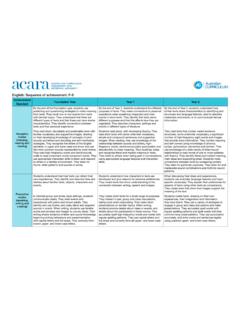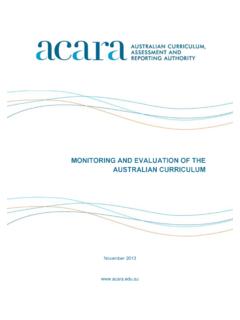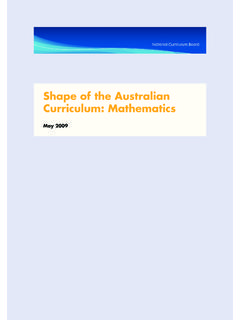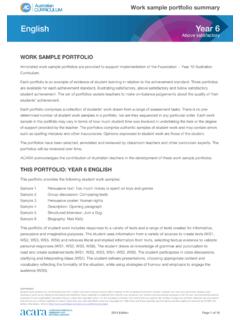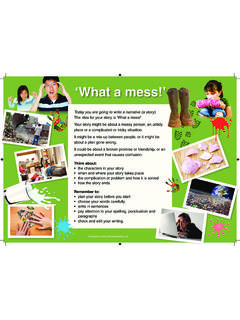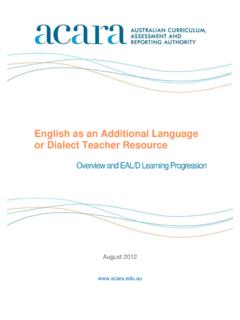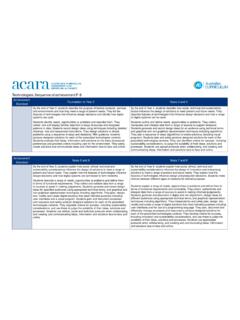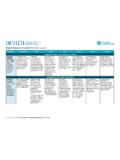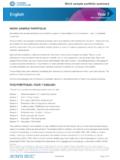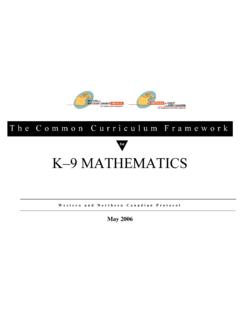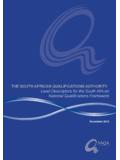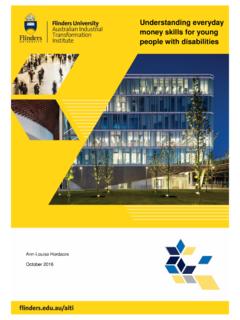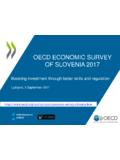Transcription of Curriculum Design Paper v2.0 051109 1 - ACARA
1 Curriculum Design Contents 1. INTRODUCTION .. 3. Purpose .. 3. Related documents .. 3. 2. THE CONTEXT FOR AN AUSTRALIAN NATIONAL Curriculum .. 4. 3. ELEMENTS OF THE NATIONAL Curriculum .. 5. Curriculum Content .. 5. Achievement Standards .. 5. Reporting framework .. 6. 4. Design CONSIDERATIONS FOR THE 7. Nature of the learner and learning .. 7. The whole Curriculum .. 9. Structural matters .. 10. Inclusivity .. 11. General 13. Cross- Curriculum perspectives .. 15. 5. TECHNICAL SPECIFICATIONS: K-10 .. 16. Rationale .. 16. Aims .. 16. Organisation of the <learning area> Curriculum .. 16. Curriculum Content .. 17. Achievement Standards .. 21. General 23. Cross- Curriculum perspectives .. 23. Links to other learning areas .. 24. 6. TECHNICAL SPECIFICATIONS: SENIOR SECONDARY 25. Rationale .. 25. Aims .. 25. Organisation of learning.
2 25. Curriculum Content .. 26. Assessment .. 27. Achievement Standards .. 27. General 28. Amendment History Date Version Comment 18 May Approved by the ACARA Board (21-22 May). Amended to include changes approved by the ACARA Board (6- 7 October); separation of specification for K-10 and senior 05 November secondary; update on achievement standards. Curriculum Design Paper 2 November 2009. 1. INTRODUCTION. Purpose This document provides background information to guide the writing of the first two phases of national Curriculum (English, mathematics, science, history, geography, languages and the arts). and includes instructions to writers on specific actions that they need to take in the drafting of the Curriculum . The document will be revised from time to time, taking account of issues that have arisen during the Curriculum development process and/or as the scope of national Curriculum changes.
3 Related documents This document, on technical matters related to the development of the national Curriculum , should be read in conjunction with other key documents, namely: The Shape of the Australian Curriculum The Shape of the Australian Curriculum : English The Shape of the Australian Curriculum : Mathematics The Shape of the Australian Curriculum : Sciences The Shape of the Australian Curriculum : History The National Curriculum Development Process National Curriculum in the Senior Secondary Years Position Paper Curriculum Design Paper 3 November 2009. 2. THE CONTEXT FOR AN AUSTRALIAN NATIONAL Curriculum . Promoting world-class Curriculum and assessment Curriculum will be designed to develop successful learners, confident and creative individuals and active and informed citizens. State, Territory and Commonwealth governments will work together with all school sectors to ensure world-class Curriculum in Australia.
4 Together the national Curriculum and Curriculum specified at the State, Territory and local levels will enable every student to develop: A solid foundation in knowledge, understanding, skills and values on which further learning and adult life can be built Deep knowledge, understanding, skills and values that will enable advanced learning and an ability to create new ideas and translate them into practical applications General capabilities that underpin flexible and analytical thinking, a capacity to work with others and an ability to move across subject disciplines to develop new expertise Melbourne Declaration on Educational Goals for Young Australians December 2008. Building Australia's future Education plays an important part in forming the young people who will take responsibility for Australia in the future.
5 If it is to play this part effectively, education must address the intellectual, personal and social development of young Australians, and it must do so at a time when ideas about the goals of education are changing, and will continue to change. The Shape of the Australian Curriculum May 2009. A Curriculum for the 21st century will reflect an understanding and acknowledgment of the changing nature of young people as learners and the challenges and demands that will continue to shape their learning in the future. Young people will need a wide and adaptive set of skills to meet the changing expectations of society and to contribute to the creation of a more productive, sustainable and just society. Curriculum is only one element that influences how well young Australians are prepared for their futures by their education, but it is important because it sets the level of expectation of their learning.
6 High-performing countries set high expectations. They support the fulfilment of those expectations with high-quality teaching, school and system leadership, and commitment and support from families, communities, business and industry. Providing high quality education is valuable to the community at large, and justifies people's investments of time, effort and resources. Curriculum Design Paper 4 November 2009. 3. ELEMENTS OF THE NATIONAL Curriculum K-12. The national Curriculum will be developed as a web-based document using web technologies to embed links and enable multiple views and access. The three key elements of the national Curriculum will be Curriculum content, achievement standards and a reporting framework. While these three elements are described separately in this document, they will be published together as a whole, integrated package.
7 The Curriculum content, achievement standards and reporting framework will be presented with other information that sets the context for what is to be taught. This information will be presented in the following sections. Rationale Aims of the learning area Organisation of the <learning area> Curriculum General capabilities Cross- Curriculum dimensions Curriculum Content Curriculum content identifies what teachers are expected to teach and students are expected to learn. Curriculum content includes knowledge, skills and understanding that students are expected to learn and will be described for a particular learning area at a particular year level (for example, Mathematics, Year 5). For K-10, Curriculum content will be presented as content descriptions' outlining what students are expected to learn and teachers are expected to teach at each year level.
8 K-10 content descriptions will be accompanied by content elaborations' which will illustrate and/or clarify the detail of the content descriptions. For the senior secondary years, Curriculum content will be presented as detailed content descriptions only. Achievement Standards Achievement standards will describe the quality of learning students should typically demonstrate in relation to the content by a particular point in their schooling (that is, the depth of their understanding, the extent of their knowledge and the sophistication of their skills). Achievement standards will be designed to support reporting to students and parents and to aid consistency of assessment and reporting across states and territories. K-10. Achievement standards will describe the quality of learning (depth of understanding, extent of knowledge and sophistication of skill) expected of students at each year level from Kindergarten to Year 10.
9 The set of achievement standards should present a continuum of typical growth expected of students across the years of schooling K-10. Each achievement standard will make explicit the quality of learning necessary for students to be well able to progress to the next level. Each K 10 achievement standard will be aligned with a C level on the reporting framework. Curriculum Design Paper 5 November 2009. For each learning area (or strand of learning area as necessary) each achievement standard will comprise a description of the quality of expected learning, and a set of annotated work samples that illustrates the described quality of learning. Senior secondary years For the senior secondary years, course-specific achievement standards will be developed. They will provide an expectation of the quality of learning that students should typically demonstrate (that is, the depth of their understanding, the extent of their knowledge and the sophistication of their skills).
10 The achievement standards will provide a 5 point scale for describing how well a student has achieved what they were expected to learn in a course. Work samples will illustrate typical learning in relation to the five levels of achievement. They will be designed to be applicable in jurisdictions with external examinations and with school-based assessment. Reporting framework In conjunction with the development of Curriculum content and achievement standards, the national Curriculum will provide a consistent nomenclature to describe the quality of achievement associated with each A E grade for use across K 10. These descriptors will be generic across year levels and learning areas. Each K 10 achievement standard will be aligned with a C level on this reporting framework. A D level on the reporting framework describes a quality of learning that is adequate for progression but may indicate the student will need additional support or assistance in progressing within the next level.
